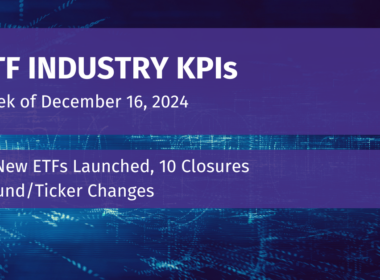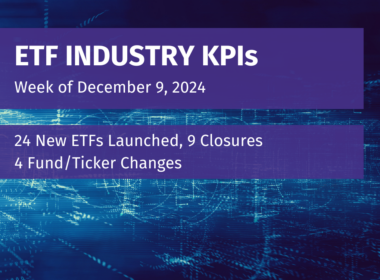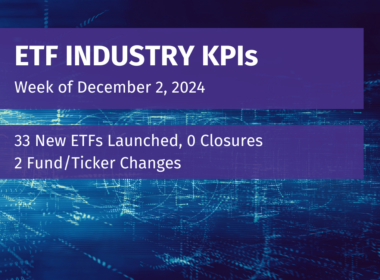When we first embarked on our NFT experiment, we wanted to achieve two main goals.
The first was to learn the how: How to create NFTs, how to code, how to put it in a marketplace, how to access it.
The second was to explore the why: Why do we need NFTs? Why should ETF investors learn about them? Why are they meaningful to the future of ETFs?
We tackled the “how” with novice enthusiasm and came out of that experiment with only a few bruises (to the ego) to show. Our learning curve in creating the ETF Nerd NFTs is detailed in two blogs, here and here. (You can mint your own ETF Nerd NFT on our website and join this educational effort – it’s free, except for gas money.)

Today, we tackle the tricky question of “why.”
As ETF investors, advisors, and industry participants, why are NFTs important to us?
The answer is still part art part science, and that’s because it’s still too early days for NFTs. This isn’t yet the time for great conviction as much as it’s the time for creative thinking. As new NFTs are developed with every new project, we consider new possibilities of where NFTs and ETFs as investment technologies collide. This is the definition of uncharted territory.
The good news is that, as ETF investors, we’ve been here before. Not even 30 years ago, when the exchange-traded fund was first coming to market to disrupt pooled investments, there were more questions than answers. Today, we know ETFs went on to become the fastest growing wrapper for the decades that followed the launch of the SPDR S&P 500 ETF (SPY) – an investment technology that is still attracting first-timer buyers, sellers, and product developers for the very first time.
So, what do we know about NFTs today?
- They offer community.
In one of our recent Get Think Tanked shows, we talked to Sergio Silva, who heads digital asset custodian Fireblocks, and asked him why NFTs matter. Silva himself comes from an ETF background, and as an investor has relinquished his ETF assets for NFT projects.
His answer was simple: NFTs are designed to capture the intangible value of things, and to monetize that value.
In real-world application, the most common occurrence of that “intangible capture” today is access to a community. NFTs, through the collectible art vector, are often used as gateway to membership into a wider group – you are literally minting your place into a community you want to belong to, be that the Bored Apes or Crypto Punks or ETF Nerds.
The intangible value of community is not foreign to us, ETF folks.
We’ve long used that word—that concept—to describe our collective bond in the pursuit of better investment outcomes. We do that through ETFs. Community is a powerful concept that’s now (again) reinforced by NFTs. Look at the massive amount of money investors are willing to pay for some of these NFTs and you, too, will marvel at just how much value we ascribe to belonging.
- Communities aren’t all created equal. Utility differentiates them.
The idea of community is compelling, and with NFTs you get a cool piece of art attached to it, but why is this meaningful in the context of investing?
We asked VettaFi Financial Futurist Dave Nadig for his take on NFTs. Nadig is an ETF expert who’s in the business at looking at what’s next. The conversation, which you can check out in its entirety here, begins with a sensible sobering insight: “We are still trying to figure out what to do with NFTs.”
As a technology today, Nadig says, NFTs are still a “very narrow capability built into the Ethereum blockchain.”
But we already know enough to know that not all NFTs are delivering the same experience or the same value. This is perhaps the first parallel NFTs have to ETFs – behind a cool wrapper lies all sorts of different things.
We can be quick to use broad brushstrokes to paint rosy pictures – digital assets are cool! – but evaluate you must. In ETFs, we say you must look under the hood to understand what you own. In NFTs, the call to action is to look at the utility.
Most NFTs today offer very limited utility. But the path forward is interesting. If community is one of the best examples of NFT utility today, the next step in that utility ladder is a deeper network that offers access to services and/or products through that community membership.
The best example of that, according to Nadig, is the Bored Ape Yacht Club.
“I don’t know whether any of these things are ever going to hold legal scrutiny, but at least from a social contract perspective, if I buy the NFT for a Bored Ape, I can go start a restaurant and use the image of my ape that I bought all over the menus and everything else and promote it as being a Bored Ape Yacht Club restaurant.
“You’re effectively trying to create a piece of cultural history from the ground up instead of waiting for a big piece of content to drop — a Marvel movie, a Harry Potter movie – and then build a bunch of stuff to signal, ‘Hey, I’m a fan’. What you’ve actually done is create a generative fan base who wants to do something cool, and the content’s what’s coming second.
“The thing I’m least interested in is just what has become almost the default rarity table-based art collections that don’t particularly have any secondary utility or purpose behind them. The most interesting thing to do for me with an NFT is crack it open and see where everything points to, see how it’s put together. That’s where all the cool stuff’s going to happen. It’s what you do with these things in the future.”
- The technology of NFTs could change financial ecosystems.
NFTs today are about “attestation of ownership” of what’s primarily collectible art and a place in a community. Perhaps the most obvious or immediate application of NFT technology in the broader financial world is around the issue of identity – attestation of the self.
We live in a world that constantly requires us to confirm we are who we say we are. And no two confirmation processes are ever the same or transferrable between platforms.
“How many times a day do you have to find a password or do your second authentication to your phone? It’s a disaster,” Nadig says. “Even worse, identity is currently always held externally, meaning that if you go to Amazon, Amazon knows what it needs to know about you to let you interact with their system. Google has a whole other ecosystem. I, as the individual, don’t control any of that.”
NFTs may solve for that. Imagine a non-fungible token where only you can create, own, and use across platforms and wallets as a single identifier. That’s powerful.
There’s also the ongoing conversation around tokenization of assets, and we are already headed in that direction.
“The tokenization of securities is absolutely the future of finance, period,” Nadig says. “Removing the issues around settlement, trusted third parties wherever we can – these things allow for much more efficient markets, much more efficient price discovery.
“We’re already there in a certain sense. There’s something called the ‘set protocol’ in the crypto space – largely used by index co-op. They effectively run hands-off indexes using the set protocol where if you want to go buy a bunch of 10 coins that are all metaverse related, they’re basketed up and you buy a single security, just like an ETF, and it then goes and does the creation. It’s like a self-fulfilling authorized participant process. It’s very easy to imagine a world where if you could trade Tesla as a token, as opposed to Tesla as a stock certificate, you could just roll up any securities you wanted inside the set protocol. And everybody could launch an ETF tomorrow.”
If nothing else, the singularity of NFTs – an NFT can only have one owner at a time – could impact the basic way we account for ETF ownership today. It’s common to have an ETF own a slice of another ETF, leading us to double count ETF assets in many cases. As Nadig puts it, it’s not a “house of cards” situation, but it leads to leverage and double counting that can lead to surprises in fast moving markets.
“One of the cool things about NFTs is that it’s very difficult to create an ecosystem where that happens because the NFT only ever exists by itself,” Nadig says. “That’s the whole point. It is a non-fungible token.”
Today Vs. Tomorrow
There’s still a lot we don’t know. For now, perhaps the biggest lesson for ETF investors is that it’s ok to lack conviction when it comes to NFTs. Both as an asset and as a disruptive technology, there are still too many questions to be explored.
As Nadig puts it, what’s really important is to separate the today from the tomorrow, and to not get lost in the hype surrounding these things.
“It’s a big difference between the NFT speculative market of the now and NFTs as the technology of the future,” he says. “You have to separate the two.”
Watch the entire conversation with Nadig about NFTs and their intersection with ETFs and investing here: Why NFTs Matter To ETF Investors
Disclosure
All investments involve risk, including possible loss of principal.
This material is provided for informational purposes only and should not be considered an individualized recommendation or personalized investment advice. The investment strategies mentioned may not be suitable for everyone. Each investor needs to review an investment strategy for his or her own particular situation before making any investment decision.
All expressions of opinion are subject to change without notice in reaction to shifting market conditions. Data contained herein from third party providers is obtained from what are considered reliable sources. However, its accuracy, completeness or reliability cannot be guaranteed.
Examples provided are for illustrative purposes only and not intended to be reflective of results you can expect to achieve.
The value of investments and the income from them can go down as well as up and investors may not get back the amounts originally invested, and can be affected by changes in interest rates, in exchange rates, general market conditions, political, social and economic developments and other variable factors. Investment involves risks including but not limited to, possible delays in payments and loss of income or capital. Neither Toroso nor any of its affiliates guarantees any rate of return or the return of capital invested. This commentary material is available for informational purposes only and nothing herein constitutes an offer to sell or a solicitation of an offer to buy any security and nothing herein should be construed as such. All investment strategies and investments involve risk of loss, including the possible loss of all amounts invested, and nothing herein should be construed as a guarantee of any specific outcome or profit. While we have gathered the information presented herein from sources that we believe to be reliable, we cannot guarantee the accuracy or completeness of the information presented and the information presented should not be relied upon as such. Any opinions expressed herein are our opinions and are current only as of the date of distribution, and are subject to change without notice. We disclaim any obligation to provide revised opinions in the event of changed circumstances.
The information in this material is confidential and proprietary and may not be used other than by the intended user. Neither Toroso or its affiliates or any of their officers or employees of Toroso accepts any liability whatsoever for any loss arising from any use of this material or its contents. This material may not be reproduced, distributed or published without prior written permission from Toroso. Distribution of this material may be restricted in certain jurisdictions. Any persons coming into possession of this material should seek advice for details of and observe such restrictions (if any).













